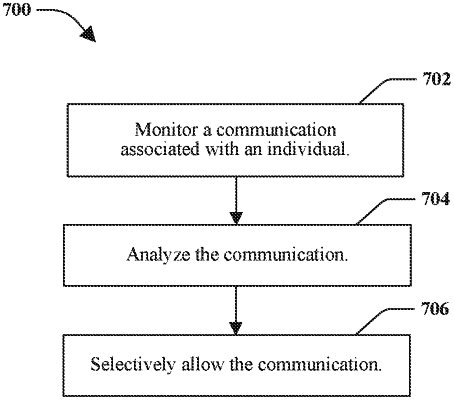| CPC G06Q 30/0185 (2013.01) [H04L 63/1483 (2013.01); H04M 1/663 (2013.01); H04M 3/2281 (2013.01); H04M 3/543 (2013.01); H04W 12/12 (2013.01)] | 20 Claims |

|
1. A method comprising:
capturing, by a computer device, in response to a trigger event, filterable communication data comprising a first communication that includes audio data corresponding to at least part of a verbal communication being transmitted by a first entity, wherein the filterable communication data indicates that an identified individual is yet to access the first communication from the first entity, and the trigger event includes a detection of one or more of key words or phrases, voice inflection, or voice stress during the verbal communication;
processing, by the computer device, the filterable communication data using a machine-learning model to generate a first classification label indicating an extent to which the filterable communication data corresponds to a predicted fraudulent activity;
before the identified individual accesses the filterable communication data, performing, by the computer device, a first corrective action based on determining that the first classification label of the filterable communication data indicates the predicted fraudulent activity, wherein the first corrective action includes discarding the filterable communication data to prevent the identified individual from receiving the filterable communication data;
accessing, by the computer device, a first feedback for the first corrective action;
adjusting, by the computer device, one or more parameters of the machine-learning model based on the first feedback;
capturing, by the computer device, based on a set of sensors, unfilterable communication data associated with the identified individual, wherein the unfilterable communication data includes a second communication that includes text data of a physical document generated by a second entity, wherein the unfilterable communication data indicates that the identified individual has accessed the second communication, and wherein:
a video sensor of the set of sensors captures the text data of the second communication in response to an interactive chatbot prompting the identified individual to hold one or more pages of the physical document in front of the video sensor;
processing, by the computer device, the unfilterable communication data using the machine-learning model to generate a second classification label indicating an extent to which the unfilterable communication data corresponds to another predicted fraudulent activity;
performing, by the computer device, second corrective actions based on determining that the second classification label of the unfilterable communication data indicates the other predicted fraudulent activity, wherein the second corrective actions include: (i) intercepting and discarding one or more outgoing communications transmitted by the identified individual to prevent the second entity from accessing the one or more outgoing communications; and (ii) sending an alert to the identified individual to discard the physical document;
identifying, by the computer device, a second feedback of the second corrective action; and
further adjusting, by the computer device, the one or more parameters of the machine-learning model based on the second feedback.
|